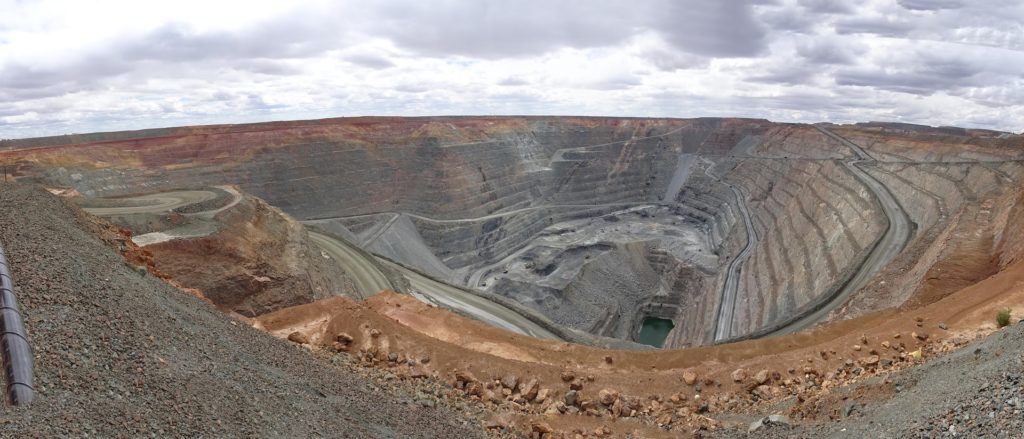Gold Mine Output Falls for First Time Since 2008
After flat-lining over the last several years, gold mine output fell by 1% in 2019. This is further evidence that we could be heading into a long-term and perhaps irreversible decline in gold mine production.
According to the World Gold Council, total gold mine output in 2019 came in at 3,463.7 tons.
A particularly weak fourth quarter drove the overall decline in gold production. Mine output fell 2% year-on-year in Q4 to 859.5 tons. According to the WGC, it was the lowest level of fourth-quarter mine output since Q4 2016.
Gold production declined year-on-year in every quarter of 2019.
Although last year marked the first absolute decline in gold production since 2008, it continues a general trend of falling mine output. Gold mine production was up a modest 77.72 tons between 2015 and 2016, 33.92 tons between 2016 and 2017, and 28 tons between 2017 and 2018.
Historically, mine production has generally increased every year since the 1970s. There was a drop in production in 2008, but that was something of an anomaly, as it occurred at the onset of the 2008 financial crisis. The recent slowdown in mine production is more concerning. In fact, many people speculate we may be at or near “peak gold.”
Peak gold is the point where the amount of gold mined out of the earth will begin to shrink every year. Some prominent players in the mining industry think we’re close to that point.
Over the last couple of years, several gold-mining executives have warned we have found most of the world’s minable gold. For instance, last year, Goldcorp chairman Ian Telfer said, “We’re right at peak gold here.” And during the Denver Gold Forum in September 2017, World Gold Council chairman Randall Oliphant said he thought the world may have already reached that point. Franco-Nevada chairman Pierre Lassonde has also indicated he expects a significant dip in gold production in the coming years. And last spring, a report in Deutsche Welle made the case that we’re approaching peak gold.
Case in point – South Africa was once the world’s leading gold producer. It’s now dropped to number nine globally. In 2018, a study came out saying South Africa could run out of gold within four decades. Analysts say that at current production levels, the country has only 39 years of accessible gold reserves remaining.
China ranks as the world’s largest gold producer. Chinese mine output fell 6% y-o-y in 2019, marking the third consecutive year of decline.
Overall gold supply was actually up about 2% in 2019 due to a surge in recycling with gold prices on the rise. According to the WGC Recycled gold supply rose 16% y-o-y in Q4, totaling 335 tons. This brought the annual supply of recycled gold to 1,304.1 tons in 2019. That was the highest total since 2012.
But recycled metal cannot meet demand over the longterm.
The biggest problem facing miners is that the easy to mine gold has mostly been dug out of the earth. We’ve had a three-decade decline in the discovery of new gold deposits despite increases in exploration funding. CFRA Research analyst Matthew Miller told Deutsche Welle that gold miners are struggling to grow reserves in line with production.
The largest and most prolific reserves have already been found.”
Even with gold prices rising, mining companies are having a difficult time coving the higher cost of mining the harder to reach, lower-quality deposits of gold left in the earth.
“We continue to try and manage costs in order to ensure the sustainability of the operations. Given the above-inflation increases in wages (approximately 50% of operating costs) and electricity prices (approximately 20% of operating costs), this has been a challenge,” Senior vice president at Sibanye-Stillwater James Wellsted told MoneyWeb.
When we look at the future of gold, it’s easy to get caught up in the latest geopolitical turmoil or the most recent policy pronouncement by the Federal Reserve. Of course, it’s important to keep abreast of the latest developments in the news cycle. But investors should never lose sight of the most basic fundamentals – supply and demand. The gold industry may well be entering a long-term — and possibly irreversible — period of less available gold. As mining companies find it more difficult to pull gold out of the earth, it will mean less gold for refiners to produce for the consumer market. Remember, gold gets its value from its scarcity.





 Since Nayib Bukele became president of El Salvador, El Salvador has been in American media and global political discussion more than ever. While much of the attention focuses on Bukele’s mass incarceration of gang members and a decline in homicide of over 70%, Bukele has also drawn attention to his favoritism towards Bitcoin and how he […]
Since Nayib Bukele became president of El Salvador, El Salvador has been in American media and global political discussion more than ever. While much of the attention focuses on Bukele’s mass incarceration of gang members and a decline in homicide of over 70%, Bukele has also drawn attention to his favoritism towards Bitcoin and how he […] With gold hitting yet another awe-inspiring all-time high in the wake of Powell’s remarks reassuring markets (more or less) to expect rate cuts in 2024, a few analysts are pointing out risk factors for a correction — so is there really still room to run?
With gold hitting yet another awe-inspiring all-time high in the wake of Powell’s remarks reassuring markets (more or less) to expect rate cuts in 2024, a few analysts are pointing out risk factors for a correction — so is there really still room to run? Gold hit a new all-time nominal high, surpassing the previous record set in December of the previous year. The precious metal’s price reached approximately $2,140, indicating a robust and continuing interest in gold as a safe-haven asset, despite a rather peculiar lack of fanfare from the media and retail investors. This latest peak in gold […]
Gold hit a new all-time nominal high, surpassing the previous record set in December of the previous year. The precious metal’s price reached approximately $2,140, indicating a robust and continuing interest in gold as a safe-haven asset, despite a rather peculiar lack of fanfare from the media and retail investors. This latest peak in gold […] The gold price has been surging, with unprecedented central bank demand gobbling up supply. It has been a force to behold — especially as US monetary policy has been relatively tight since 2022, and 10-year Treasury yields have rocketed up, which generally puts firm downward pressure on gold against USD.
The gold price has been surging, with unprecedented central bank demand gobbling up supply. It has been a force to behold — especially as US monetary policy has been relatively tight since 2022, and 10-year Treasury yields have rocketed up, which generally puts firm downward pressure on gold against USD.  Total gold demand hit an all-time high in 2023, according to a recent report released by the World Gold Council. Last week, the World Gold Council (WGC) released its Gold Demand Trends report, which tracks developments in the demand for and use of gold around the world. Excluding over-the-counter (OTC) trade, 2023 gold demand fell slightly from 2022 […]
Total gold demand hit an all-time high in 2023, according to a recent report released by the World Gold Council. Last week, the World Gold Council (WGC) released its Gold Demand Trends report, which tracks developments in the demand for and use of gold around the world. Excluding over-the-counter (OTC) trade, 2023 gold demand fell slightly from 2022 […]